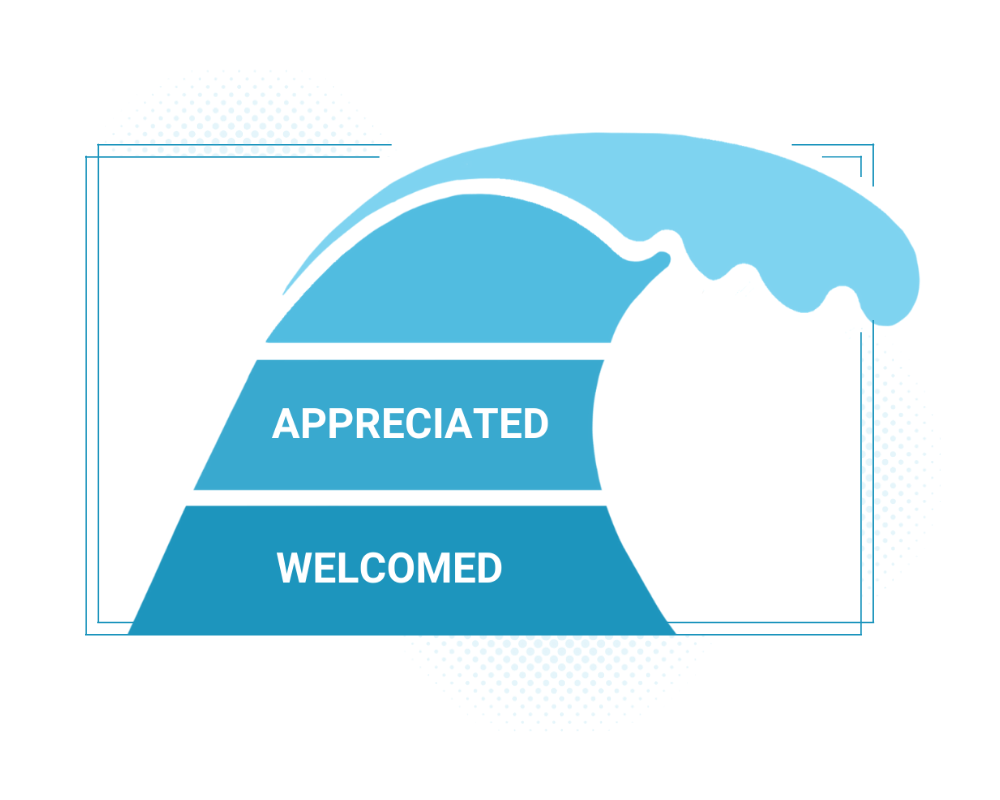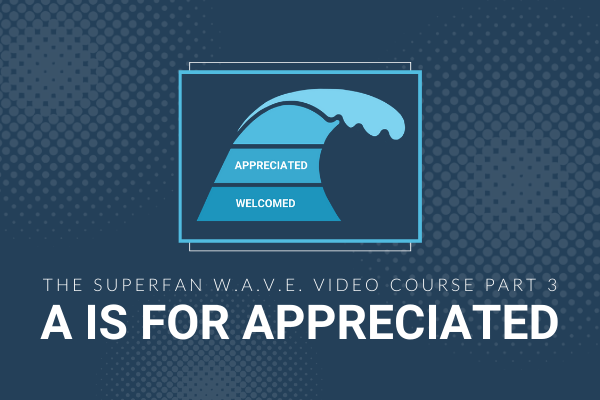Rather than kick off this blog with business, let’s get personal for a moment, and think about your best friend. If they told you they felt perpetually unappreciated by their partner, what would you tell them? You’d tell them to end the relationship, that they deserve to be with someone who treats them like they matter, right? That’s because appreciation is crucial to building a healthy relationship, and, when it comes to customer retention, your relationship with your customers is no exception. Just as in a personal partnership, your customers want to be sure that they’re investing in a partnership that truly values their support. If they feel like their patronage doesn’t matter – as if they’re just another number – there’s a strong chance they’ll look for a partner who treats them better.

In this guide, part three of my Superfan W.A.V.E. blog series, we’ll cover three ways to avoid this all-too-common occurrence including the importance of systems for collecting and reviewing customer feedback. We’ll also break down the math behind customer retention and how a simple “thank you” to your customers can make a world of difference.
If you missed the previous two blogs, no worries! Sign up for my free five-day W.A.V.E. video course to help you get started! Each video is jam-packed with tips and tricks to inspire your team in the sink-or-swim world of customer service (and, if you’re wondering if the videos come with puns, too, they absolutely do! 😁 ).
Recap of the Superfan W.A.V.E.
Before we jump into the “appreciation” aspect of the W.A.V.E. method, let’s look at it from a bird’s eye view. For anyone jumping in without having read the previous two blogs, the Superfan W.A.V.E. starts with the term “superfan.” Like the word “fan,” superfans have had great experiences with your brand and your products or services. However, rather than simply keeping those experiences to themselves, super-fans share those experiences with their network, sending more potential superfans your way.
Likewise, the “W.A.V.E.” acronym represents ways to create these superfans, including making customers feel welcomed, appreciated, validated, and engaged. Although they sound simple enough, consistently reinforcing these emotions for your customers doesn’t just result in happier customers. It also builds a relationship between them and members of your team. That way, they know they can come to you with questions or concerns (and still be taken seriously) and you know you can rely on them for honest feedback and referrals. It’s a win for you, your team, and your customers, and all it costs is some extra care for your customers in the first place.
The Importance of Appreciating Customers
Appreciating your customers may sound like common sense or the old Golden Rule of “treat others how you want to be treated.” However, real appreciation isn’t simply a “thank you” card once a year or a holiday gift in the winter. It’s consistent and meaningful words and actions to show that you care about your customers well beyond the point of sale and that you value your investment, whether it was a one-time sale or an ongoing subscription.
A great example of what not to do can be seen in many satellite, cable and/or internet providers. Although there are exceptions, many of these companies are notorious for treating customers like nameless faces in a crowd. They value your money, not your individual questions, concerns, or feedback, and justify their poor service with empty arguments or scripted apologies. As a result, they’re often among the lowest Net Promoter Score benchmarks. In other words, customers don’t feel loyal to these types of companies, and it shows. In fact, feeling unappreciated is the number-one reason customers switch products, services, and companies, even if they were initially satisfied.
On the flip side, there are a plethora of other businesses to mimic if you’re unsure what appreciation looks like. Take Chick-fil-A, for example. Based in Georgia, this fast food chain is well-known for its clean restaurants, polite staff, and delicious food. At almost every location, you’ll hear “thank you”s or “my pleasure”s from employees as a common response. They’ve made customer appreciation a core competency of their culture, and it has helped them become one of the most profitable and fastest-growing franchises in the world.
Likewise, showing appreciation isn’t just sure to give you a good reputation. It’s also certain to create superfans time and time again.
How To Make Your Customers Feel Appreciated
If you want to provide customers with exceptional service, the first step is asking them what that appreciation looks like. I’ve talked about this before in my outline of the Superfan System, but it’s worth repeating. Businesses should operate on the “Platinum Rule” (or “Treat others the way they want to be treated”) rather than the aforementioned Golden Rule. After all, you create products and services with your customers in mind. Shouldn’t your customer service efforts be structured in the same way?
That said, before contacting your current superfans, it’s also important to look at your company from your own position. Consider your existing appreciation efforts, and reflect on the following questions:
- What would it look like if you made appreciation a core value of your company?
- Which specific systems and processes can you establish to instill appreciation at every level of your company?
- What steps can you take to automate it, so that appreciation becomes a company habit?
Between your answers to these questions and your customers’ feedback, you’ll be able to construct a plan for how you can show appreciation that not only makes you look attentive and caring but also truly means something to your customers. And, who knows? Even one small change, whether it’s training employees or updating a confirmation email to thank customers for their purchase, can have a profound impact on customers’ perception of your brand and their loyalty to it.
Gift strategically to show that you care.
One way to build customer retention through appreciation is simple: gifts! Strategic gifting is a given in most customer-centric businesses, as it doesn’t simply say that you care about your customers. It shows them you care. A meaningful gift can also show the attention you pay to each of your customers as individuals. It’s tangible evidence that you don’t simply see them as a sale. You remember their likes and dislikes and the personal information they’ve trusted you with.

When giving gifts, however, there are a few general “don’t”s to keep in mind. First, don’t give any gifts with your name or logo on them. If it has your branding on it, it’s not a gift – it’s a promotion. Second, if you don’t know a customer well, keep things simple and less personal. The only thing worse than not giving a gift is giving one that’s ill-suited to the recipient. For example, you wouldn’t gift peanut butter cookies to someone with nut allergies or wine to someone that doesn’t drink. Lastly, don’t just gift your clients. Give a gift they can share with their partner or family, too! Especially if they’re in a high-stress role or a busy business of their own, sometimes the best gift can be taking a break from work altogether.
If you’re new to professional gift-giving, the most important thing to keep in mind is to listen to your customers. Then, simply base your gifts off of their preferences. Just like the Platinum Rule, no one will tell you what a customer wants more than the customer themself. Plus, if you’re at a total loss, you can always brainstorm with my client gifting guide, too.
On top of showing you care, make sure to tell customers you care, too.

That said, as important as gifts are in customer retention strategies, it’s equally important to tell customers you care. Whether it’s via phone, emails, notes, etc. consistent appreciation shows customers you’re not just there for big moments, like referrals. You’re also there for small moments, like renewing their product subscription or leaving a review on social media. Even in seemingly ordinary situations, a simple “thank you” can mean a lot.
Looking back at our relationship analogy from the beginning of this guide, telling customers you appreciate them should be consistent and frequent practice. Like a couple thanking each other for helping around the house or a person thanking their waiter for a meal, expressing your gratitude should be a given in your team members’ conversations with customers. That way, your customers feel appreciated in every interaction. Plus, being grateful and polite never hurt a company’s reputation, so there’s really nothing to lose besides a little bit of time. I don’t know about you, but, I’d say that’s well worth the effort if it creates superfans in the long run.
Show appreciation all the time, not just on special occasions.
Lastly, make sure you show appreciation to your customers all the time, not just on holidays or special occasions. Again, authentic appreciation means being grateful for the little moments as well as the big ones, no matter how new a customer is or how little they’ve purchased. In my own business, for example, I’m a huge fan of celebrating smaller holidays with my clients. I’ve sent Valentine’s Day cards, half birthday offers, even illustrated thank you cards with puns on the cover (I don’t know if you’ve noticed, but I’m a big fan of those!).

Alternatively, besides holidays, another way to show appreciation is by offering sales for customers at certain levels. As a White House Black Market member, for example, I’ve received special gifts a few times a year, as a “thank you” for my subscription. However, I’ve also received account credits tailored to the age of my account and my membership level. I’ve even received emails tailed specifically to me, based on what I’ve bought before and with real stylist recommendations. This not only shows me that they value my experience, as a customer. It also makes me look forward to their emails, as they make my buying experience better every time. Win, win!
In the long run, remember that appreciation is just one component of a solid customer retention strategy, and validating and engaging customers is equally important, as we’ll cover in additional guides.
For the time being, if you want to learn more, check out the next step in my Superfan Series, “Satisfying Unhappy Customers: How To Right Inevitable Wrongs For Your Clients.”
Additionally, feel free to hit me up @BrittanyHodak on social media, too, and share the ways your favorite brand has shown you they care! 💓
